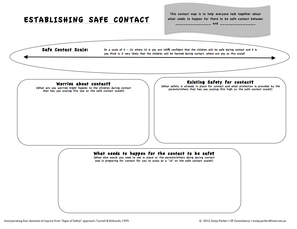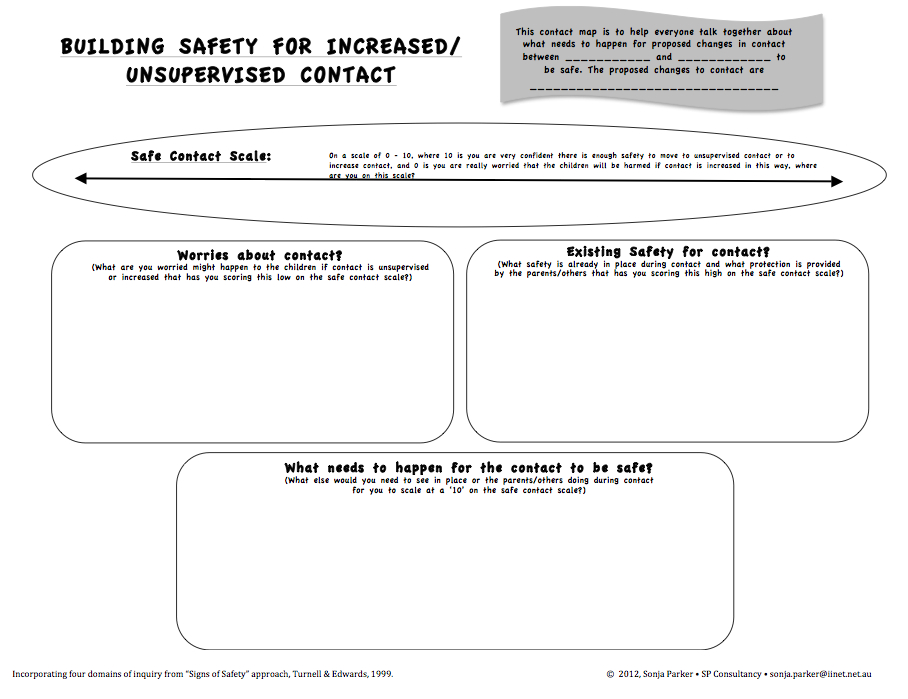My blog this week is a bit of a mixture of words and video and is all about contact/visitation. Involving families and safety network members in decision-making and planning around contact visits (visitation) is a powerful way to begin the process of collaborative safety planning. I've recently developed the "Safe Contact" tool, which is a tool that is designed to help professionals work collaboratively with parents, children and safety network members to plan for safe contact visits. The "Safe Contact" tool focuses on collaborative planning for contact as a building block for long term safety. The "Safe Contact" tool is designed to be used with families and their networks over the entire period of working with a family to ensure that decision-making about contact is collaborative, transparent and centred on safety, from the moment that the children come into care until the children are safely returned to the care of their family and the case is closed. The "Safe Contact" tool can be downloaded as a pdf by clicking here.
I've developed a video clip that provides some more detail about the "Safe Contact" tool (thanks Catherine Bettison for doing the filming) and you can view it on youtube: http://youtu.be/3mugsoKTUKE And if you would like to subscribe to future blogs, please enter your email in the subscribe box in the right hand column. Wishing you all the best in your work with families, Sonja
4 Comments
Mutually-Constructed Safety GoalsHi everyone, This blog focuses on the process of developing mutually-constructed safety goals (goals that are developed collaboratively between the parents/family and the child protection agency) and follows on from my earlier blog about danger statements. If you haven’t read that blog (22/9/13), you might want to read that first so that you have sufficient context for the information contained in this blog. Safety goals are clear, behavioural statements that describe WHAT the parents will be doing differently in their care of the children in the future to protect the children from the identified dangers and for the child protection agency to be willing to close the case. The safety goals provide a vision for future safety and the focus and direction for the creation of rigorous safety plans. One of the most common pieces of feedback from families who are involved with child protection systems is that professionals constantly “shift the goal posts” or fail to define the “goal posts” in the first place. The process described in this blog is designed to directly address this issue so that child protection practitioners are able to work with families to collaboratively define the safety goals and then maintain this safety focus in their work with the family. Just as with the danger statements, the process of developing mutually-constructed safety goals starts with workers initially thinking through and identifying their own views on the safety goals. Once workers have developed their own version of the safety goals, they can then put these aside and use a questioning approach with family members and other significant people to elicit the family/safety network’s views on the safety goals. In this way, workers can move from professionally-created safety goals to safety goals that are mutually-constructed with the family and the safety network (if they are involved at this stage). Identifying and writing clear safety goals is one of the aspects of collaborative assessment that child protection workers typically find most challenging. If you would like more information about safety goals and how to write clear and comprehensive safety goals, please see the “Partnering for Safety” framework booklet in my bookshop. This blog will assume you have that understanding about safety goals and will work forward from the point where you have already identified your own version of the safety goals. Eliciting families' views on the safety goals When I am ‘mapping’ with a family, the safety goals element is the part of the framework that I frequently start with, particularly with families where we have or could get stuck in arguments about what happened in the past. Asking parents to describe their ideas and hopes and dreams for keeping their children safe in the future enables our conversation to focus on a vision for future safety, rather than getting stuck arguing about the past. And what I have learnt is that when families are able to talk with us about their visions for the future, hope and energy enters the room and enables us to start to build a platform for working together to create future safety. Time after time, when I have used careful questioning with parents to elicit their safety goals for their children, parents usually come up with most, if not all, of the desired changes that child protection services have identified within their safety goals. The key in eliciting specific and safety-focused goals with parents is using specific, purposeful and safety-focused questions that invite the parents to reflect on future safety for their children and to create a vision for future safety. In asking parents about their safety goals, the initial question I ask is usually something like one of the questions below:
I usually choose one of these questions (usually relying on my instinct about which will be most effective) and if that question isn't one that the person connects with, then I try another. The question you ask is likely to elicit only some of the parent’s ideas, so you will need to ask (and continue asking) “And what else would you be doing?” until parent/family member has identified all of their ideas. As parents are identifying their safety goals, you can use follow up questions to help parents refine their safety goals to ensure that they are focused on the children, that they describe the changes in their behaviour and that the safety goals cover all of the identified concerns. The “Partnering for Safety” framework booklet contains a large number of suggested follow up questions that you can use with families to help focus and refine the safety goals. Asking parents to reflect on the agency safety goal After eliciting the family’s safety goals, you can then move into asking the parents to consider what the agency safety goals might be. I usually do this only after I have used careful and extensive questioning with the parents to elicit their own safety goals and we have worked through the danger statements together, so that parents can reflect on what future actions they think the child protection agency would need to see them take to protect the children from the dangers. The place that I usually start is by first acknowledging the ideas that the parent has provided, and then asking them to consider which of these ideas or safety goals they think would be most important for child protection to see in place. I usually ask a question such as:
Once we have explored the parts of the parent’s safety goals that would be important to CPS, we then move to identifying any additional safety goals that CPS would need to see.
Developing mutually-constructed safety goals Once you have elicited the family’s safety goals and asked the family to reflect on the agency safety goals, you can then use a questioning approach to combine the different safety goals into one set of safety goals that are reflective of both the family’s ideas and the safety requirements of the agency. Combining the safety goals will often involve incorporating the family’s language or adding goals that are important to the family, but does NOT involve diluting the safety focus. I usually introduce this next part of the process by saying something like:
Then to develop one set of mutually-constructed goals, I use questions such as:
Working collaboratively to develop safety goals does not mean that everyone needs to agree on the safety goals. As discussed in my previous blog in relation to the statements of future danger, family members, safety network members and even other professionals may not agree with the concerns held by the statutory agency and so may not agree that all of the safety goals are necessary. But at a minimum, everyone needs to be involved in the process of thinking through the care and protection for the children that the statutory agency would need to see in place to be prepared to close the case. Introductory statement at the top of the safety goals At the top of the safety goals, I usually include a statement that helps everyone to understand the process of involving a safety network and working from the safety goals to develop the detailed safety plan (for more detail on this, see the “Partnering for Safety” framework booklet). To introduce the introductory statement, I usually say something like:
Exploring a time frame Once we have talked through all the details of the safety goals that need to be in place to address the danger statements and have come up with a mutually-developed set of safety goals, I then introduce the idea of these safety goals needing to be demonstrated over time. I usually say something like:
Final thoughts.... Hopefully the suggested process above will help you develop more confidence and capacity in moving from professionally-created safety goals to safety goals that are mutually-constructed with the family and the safety network (if they are involved at this stage). It is these mutually-constructed safety goals that then provide the vision and direction for our future safety planning work with the family. I've tried to keep this as brief as possible (truly; you should see how much I left out!), but I'm conscious that it's still pretty long for a blog. Hope you've been able to sit and relax with a cup of tea while you were reading it :) Feel free to get in touch if you would like to discuss this process in any more detail and for further information about danger statements and safety goals, please see the "Partnering for Safety" booklet in my bookshop. And if this is one of the first of my blogs that you are reading and you would like to subscribe to future blogs, please return to the top of the page and subscribe by entering your email address in the right hand column. Wishing you all the best in your work with families. Sonja |
Subscribe to
|


 RSS Feed
RSS Feed